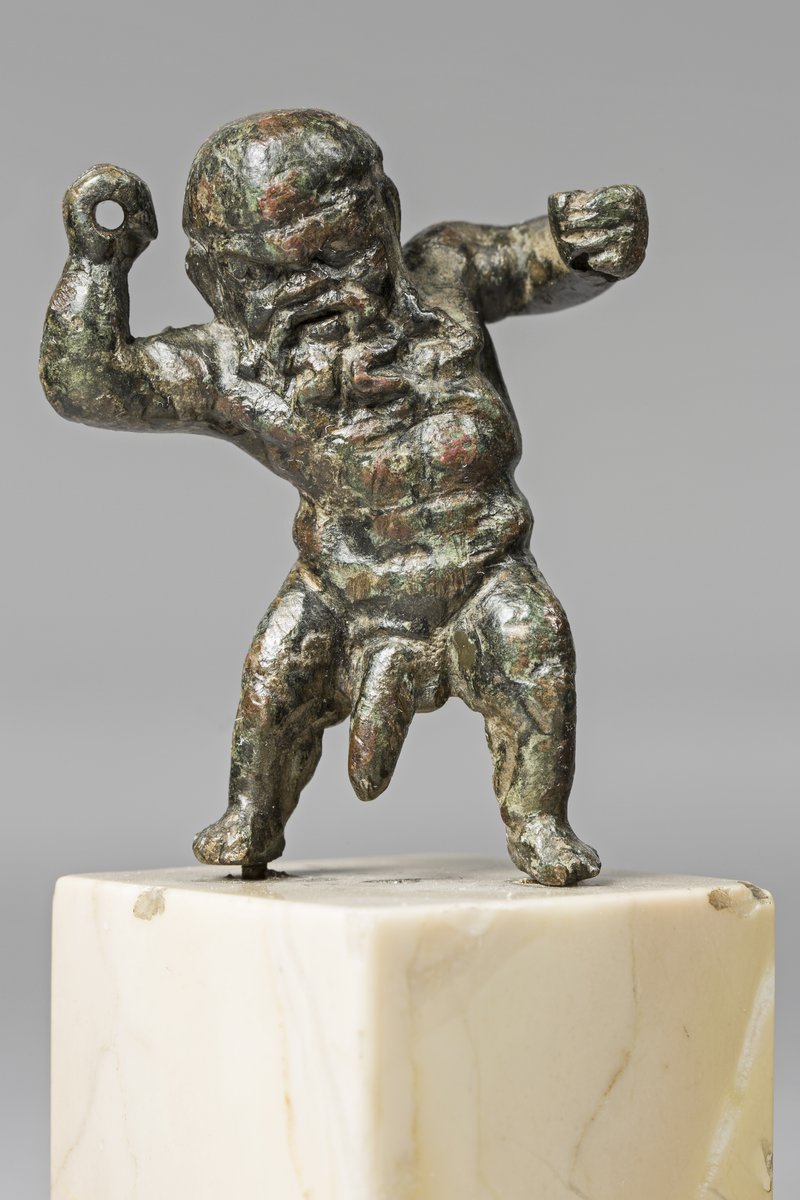
Pygmy Warrior
Classical Antiquities
| Date | first half of the 1st century B.C. |
|---|---|
| Object type | relief |
| Medium, technique | carved, marble |
| Dimensions | 33.5 x 38.2 cm |
| Inventory number | 2006.8.A |
| Collection | Classical Antiquities |
| On view | Museum of Fine Arts, Basement Floor, Classical Antiquity, Eros – Dionysos – Thanatos |
A young horseman occupies the major part of the composition framed with unadorned pillars and an architrave. The horse is lifting only its right front leg: it is strutting slowly. The depth of the figural panel is not even: it is twice as deep behind the horse than on the other side (3 and 1.5 cm, respectively); as if the horseman was stepping out of the background.The young man sitting on the wide horse blanket is wearing a short, sleeved chiton, a long mantle spread on the rump of the horse, and high sandals marked only with light carving. His hair is short and he has no beard; the face was formed not with an attempt to bear idealistic features, giving bulging eyebrows, fleshy chin and snub nose to the character. He is staring straight ahead. His right hand holds the bridle, while of the left, only the roughly carved clenched palm is visible, perhaps grasping a spear leaning on his shoulder and only indicated with paint. In both upper corners of the relief, a snake is coiling towards the horseman between summarily represented tree boughs. A figure with short hair, smooth chin, staring ahead, stands before him. His face recalls the portraits carved during the later period of the Roman Republic. His lowered left hand is kept under his mantle; and his right is shown only for his extended palm – a sign of greeting and respect. The execution of the relief, especially the oversized heads of the horse and the horseman points to the distance of the craftsman from the Classical tradition, but the whole of the composition evidences a competent sculptor. The piece is carefully polished on both sides, but its top and back are only roughly finished. The remains of the tenon, which was chiselled off later, can be observed at the bottom centre, suggesting that the relief was inserted in a supporting base.
The relief shows a moment taken from life only at first glance: the meeting of a horseman and a man afoot at the edge of the woods; but indeed, the scene is placed in sacral dimensions. It belongs to a well-known iconographic pattern widespread in the Greek world, which primarily carried the main characters of a riding hero and the followers of his cult. The scheme formed in Athens in the Classical period following patterns developed in Eastern cultures, and it became one of the most popular relief-types of the Hellenistic Oikoumene, partly helped by the progressive power of Athenian art. This type was most widespread in the Eastern part of the Greek world, including the North of the Balkan peninsula, where its popularity remained unchallenged through the periods of the Roman Empire. Though the type seems to be homogeneous at first, recent researches have been able to describe some of the groups characteristic to a particular region of this vast area (e.g., Samos, Kyzikos, Bithynia). The piece in Budapest cannot be classified in any of these groups yet. It can be dated only in general terms of the 1st century B.C.
The popularity that the relief-type of the riding hero enjoyed through the centuries is related to an important feature of Greek culture. One unique aspect of Greek religion is that besides immortal gods and men, it also knew heroes, who were similar to men in their mortality, but to gods by their very deeds. For the European tradition, the image of the hero is stamped first by the Homeric Epic with Hector and Achilles. But the term had gained a much wider use by the Hellenistic period. Besides the heroes of the mythical epoch, it could refer to the deceased, who was remembered with a memorial cult founded by his family, his city and even his friends. The sources indicate that cult was founded principally in two cases: for the outstanding, who became great through their deeds, or those who lost the chance to fulfil a promising life – those ‘who died before their time’. For the honour of the hero, often games and public banquets were founded. Two types became very popular among their representations: the banqueting and the riding hero. The former shows the main form of their cult, while the latter, the general concept behind it.
The relief in Budapest can be interpreted in this context. The youth and the elder standing man are obviously not of the same world. The deceased depicted as a solitary horseman is among his own, as suggested by the snakes turning towards him – the par excellence beasts of the hero’s world. But the living have not forgotten him either: the frame of the relief recalls the temple, the leaves the hero’s grove, and the man in the chiton is the iconographic sign for the cultores. And though the two men cannot see each other, they share the same image. Their different worlds intersect at a common point: at the memory to the dead – facing the distress of death with the power of remembrance.
Following ÁRPÁD M. NAGY
Marble analyses have shown that the relief was made of Thasian, Parian (Paros-Choriodaki) or Prokonnesian (Marmara) marble.
This record is subject to revision due to ongoing research.